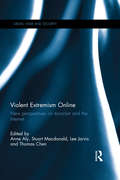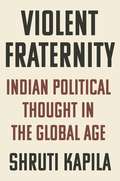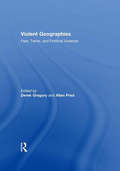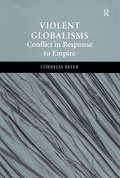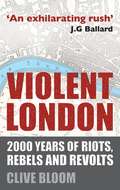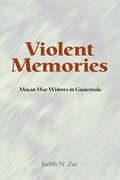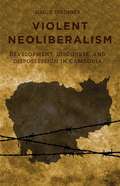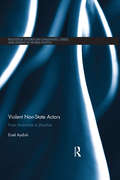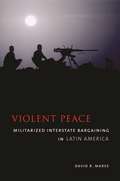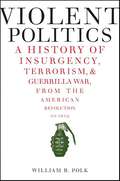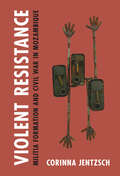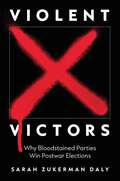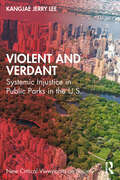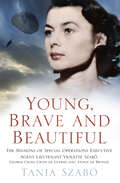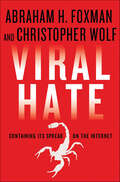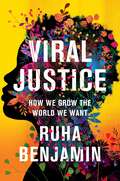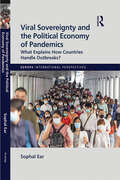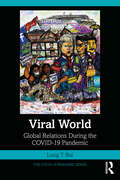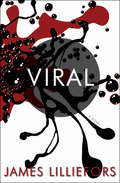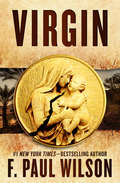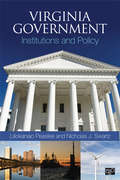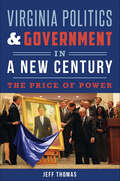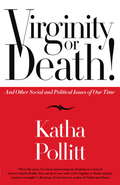- Table View
- List View
Violent Extremism Online: New Perspectives on Terrorism and the Internet (Media, War and Security)
by Lee Jarvis Stuart Macdonald Anne Aly Thomas ChenThis book explores the interface between terrorism and the internet and presents contemporary approaches to understanding violent extremism online. The volume focuses on four issues in particular: terrorist propaganda on the internet; radicalisation and the internet; counter campaigns and approaches to disrupting internet radicalisation; and approaches to researching and understanding the role of the internet in radicalisation. The book brings together expertise from a wide range of disciplines and geographical regions including Europe, the US, Canada and Australia. These contributions explore the various roles played by the Internet in radicalisation; the reasons why terroristic propaganda may or may not influence others to engage in violence; the role of political conflict in online radicalisation; and the future of research into terrorism and the internet. By covering this broad range of topics, the volume will make an important and timely addition to the current collections on a growing and international subject. This book will be of much interest to students and researchers of cyber-security, internet politics, terrorism studies, media and communications studies, and International Relations.
Violent Fraternity: Indian Political Thought in the Global Age
by Shruti KapilaA groundbreaking history of the political ideas that made modern IndiaViolent Fraternity is a major history of the political thought that laid the foundations of modern India. Taking readers from the dawn of the twentieth century to the independence of India and formation of Pakistan in 1947, the book is a testament to the power of ideas to drive historical transformation.Shruti Kapila sheds new light on leading figures such as M. K. Gandhi, Muhammad Iqbal, B. R. Ambedkar, and Vinayak Savarkar, the founder of Hindutva, showing how they were innovative political thinkers as well as influential political actors. She also examines lesser-known figures who contributed to the making of a new canon of political thought, such as B. G. Tilak, considered by Lenin to be the "fountainhead of revolution in Asia," and Sardar Patel, India's first deputy prime minister. Kapila argues that it was in India that modern political languages were remade through a revolution that defied fidelity to any exclusive ideology. The book shows how the foundational questions of politics were addressed in the shadow of imperialism to create both a sovereign India and the world's first avowedly Muslim nation, Pakistan. Fraternity was lost only to be found again in violence as the Indian age signaled the emergence of intimate enmity.A compelling work of scholarship, Violent Fraternity demonstrates why India, with its breathtaking scale and diversity, redefined the nature of political violence for the modern global era.
Violent Geographies: Fear, Terror, and Political Violence
by Derek Gregory Allan Pred"Violent Geographies is essential to understanding how the politics of fear, terror, and violence in being largely hidden geographically can only be exposed in like manner. The 'War on Terror' finally receives the coolly critical analysis its ritual invocation has long required." —John Agnew, Professor of Geography, UCLA "Urgent, passionate and deeply humane, Violent Geographies is uncomfortable but utterly compelling reading. An essential guide to a world splintered and wounded by fear and aggression—this is geography at its most politically engaged, historically sensitive, and intellectually brave." —Ben Highmore, University of Sussex "This is what a ‘public geography’ should be all about: acute analysis of momentous issues of our time in an accessible language. Gregory and Pred have assembled a peerless group of critical geographers whose essays alter conventional understandings of terror, violence, and fear. No mere gazetteer, Violent Geographies shows how place, space and landscape are central components of the real and imagined practices that constitute organised violence past and present. If you thought terror, violence, and fear were the professional preserve of security analysts and foreign affairs experts this book will force you to think again." —Noel Castree, School of Environment and Development, Manchester University "A studied, passionate and moving examination of the way in which the violent logics of the ‘War on Terror’ have so quickly shuttered and reorganized the spaces of this planet on its different scales. From the book emerges a critical new cartography that clearly charts an archipelago of a large multiplicity of ‘wild’ and ‘tamed’ places as well as ‘black holes’ within and between which we all struggle to live."—Eyal Weizman, Director, Goldsmiths College Centre for Research Architecture
Violent Globalisms: Conflict in Response to Empire
by Cornelia BeyerDuring the post-cold war world, the world's only superpower has encountered an unprecedented challenge: a non-state enemy that is challenging its hegemony and is using violence as a strategic means. Given the international nature of this phenomenon, a structured explanation such as this is given added necessity and urgency. Cornelia Beyer provides a structured explanation for terrorism and its links with the 'Global War on Terror' as it relates to the latter's broader context, causes and implications. She offers a comprehensive understanding of the phenomenon of international terrorism and proposes effective policies to counter it. She also remedies the current undertheorized nature of the subject area, and in doing so opens up new modes of thinking about and struggling against global terrorism.
Violent London
by Clive BloomAlmost as soon as it was built, London suffered the first of many acts of violent protest, when Boudica and her followers set fire to the city in AD 60. Ever since, the capital's streets have been a forum for popular insurrection. Covering nearly 2,000 years of political protest, this is a riveting alternative history of past and present conflict.
Violent Memories: Mayan War Widows In Guatemala
by Judith ZurThis local study of the impact of political violence on a Maya Indian village is based on intensive fieldwork in the department of El Quiche, Guatemala, during 1988-1990. It examines the processes of fragmentation and realignment in a community undergoing rapid and violent change and relates local, social, cultural, and psychological phenomena to t
Violent Neoliberalism
by Simon SpringerViolent Neoliberalism explores the complex unfolding relationship between neoliberalism and violence. Employing a series of theoretical dialogues on development, discourse and dispossession Cambodia, this study sheds significant empirical light on the vicious implications of free market ideology and practice.
Violent Non-State Actors: From Anarchists to Jihadists (Routledge Studies on Challenges, Crises and Dissent in World Politics)
by Ersel AydinliGiven the importance of violent non-state actors (VNSA) and their evolving role in global politics, dynamic frameworks of analysis are needed both to trace historical trajectories in the evolution of violent non-state actorness and to identify emerging patterns by examining modern day cases. This book examines the defining characteristics and evolutionary dynamics of VNSAs, and introduces a framework based on their autonomy, representation and influence providing a comparative analysis of the late 19th and early 20th centuries’ Anarchist movement and the modern-day Jihadist network. It explores the distinct characteristics of the Anarchists and Jihadists as VNSAs with global potential, not just describing them, but also seeking to understand what they are instances of. With a longitudinal analysis, the book also considers the types of changes that have occurred in the past 150 years and the possible role VNSAs may play in current and future power polity shifts away from states toward non-state actors. It concludes with both theoretical implications for the study of non-state actors and transnational relations, and practical implications for government agencies or private groups tasked with finding ways of countering such violent non-state actors. This important book will be of interest to students and scholars of international relations, political science, and terrorism/security studies. It will also be of interest to practitioners in the security services including think-tank analysts and government security analysts.
Violent Order Understanding Rebel Governance through Liberia’s Civil War
by Nicholai Hart LidowRebel groups exhibit significant variation in their treatment of civilians, with profound humanitarian consequences. This book proposes a new theory of rebel behavior and cohesion based on the internal dynamics of rebel groups. Rebel groups are more likely to protect civilians and remain unified when rebel leaders can offer cash payments and credible future rewards to their top commanders. The leader's ability to offer incentives that allow local security to prevail depends on partnerships with external actors, such as diaspora communities and foreign governments. This book formalizes this theory and tests the implications through an in-depth look at the rebel groups involved in Liberia's civil war. The book also analyzes a micro-level dataset of crop area during Liberia's war, derived through remote sensing, and an original cross-national dataset of rebel groups.
Violent Peace: Militarized Interstate Bargaining in Latin America (International Relations)
by David R. MaresWhen is military force an acceptable tool of foreign policy? Why do democracies use force against each other? David R. Mares argues that the key factors influencing political leaders in all types of polities are the costs to their constituencies of using force and whether the leader can survive their displeasure if the costs exceed what they are willing to pay. Violent Peace proposes a conceptual scheme for analyzing militarized conflict and supports this framework with evidence from the history of Latin America. His model has greater explanatory power when applied to this conflict-ridden region than a model emphasizing U.S. power, levels of democracy, or the balance of power.Mares takes conflict as a given in international relations but does not believe that large-scale violence must inevitably result, arguing that it is the management of conflict, and not necessarily its resolution, that should be the focus of students, scholars, and practitioners of international relations. Mares argues that deterrence represents the key to conflict management by directly affecting the costs of using force. Conflicts escalate to violence when leaders ignore the requisites for credible and ongoing deterrence. Successful deterrence, he suggests, lies in a strategy that combines diplomatic and military incentives, allowing competition among heterogenous states to be managed in a way that minimizes conflict and maximizes cooperation.
Violent Politics: A History of Insurgency, Terrorism, & Guerrilla War, from the American Revolution to Iraq
by William R. PolkIn the current Middle East, insurgency tactics are used with frequency and increasing success. But guerrilla war-fare is not just the tool of modern-day terrorists. Its roots stretch back to our very own revolution.In Violent Politics, William Polk takes us on a concise, brilliant tour of insurgencies throughout history, starting with the American struggle for independence, when fighters had to battle against both the British and the loyalists, those colonists who sided with the monarchy. Instinctively, in a way they probably wouldn't have described as a coherent strategy, the rebel groups employed the tactics of insurgency.From there, Polk explores the role of insurgency in several other notable conflicts, including the Spanish guerrilla war against Napoleon, the Irish struggle for independence, the Algerian War of National Independence, and Vietnam. He eventually lands at the present day, where the lessons of this history are needed more than ever as Americans engage in ongoing campaigns in Afghanistan and Iraq—and beyond.
Violent Resistance: Militia Formation and Civil War in Mozambique (Cambridge Studies in Contentious Politics)
by Corinna JentzschWhy do communities form militias to defend themselves against violence during civil war? Using original interviews with former combatants and civilians and archival material from extensive fieldwork in Mozambique, Corinna Jentzsch's Violent Resistance explains the timing, location and process through which communities form militias. Jentzsch shows that local military stalemates characterized by ongoing violence allow civilians to form militias that fight alongside the government against rebels. Militias spread only to communities in which elites are relatively unified, preventing elites from coopting militias for private gains. Crucially, militias that build on preexisting social conventions are able to resonate with the people and empower them to regain agency over their lives. Jentzsch's innovative study brings conceptual clarity to the militia phenomenon and helps us understand how wartime civilian agency, violent resistance, and the rise of third actors beyond governments and rebels affect the dynamics of civil war, on the African continent and beyond.
Violent Victors: Why Bloodstained Parties Win Postwar Elections (Princeton Studies in International History and Politics #194)
by Sarah Zukerman DalyWhy populations brutalized in war elect their tormentorsOne of the great puzzles of electoral politics is how parties that commit mass atrocities in war often win the support of victimized populations to establish the postwar political order. Violent Victors traces how parties derived from violent, wartime belligerents successfully campaign as the best providers of future societal peace, attracting votes not just from their core supporters but oftentimes also from the very people they targeted in war.Drawing on more than two years of groundbreaking fieldwork, Sarah Daly combines case studies of victim voters in Latin America with experimental survey evidence and new data on postwar elections around the world. She argues that, contrary to oft-cited fears, postconflict elections do not necessarily give rise to renewed instability or political violence. Daly demonstrates how war-scarred citizens reward belligerent parties for promising peace and security instead of blaming them for war. Yet, in so casting their ballots, voters sacrifice justice, liberal democracy, and social welfare.Proposing actionable interventions that can help to moderate these trade-offs, Violent Victors links war outcomes with democratic outcomes to shed essential new light on political life after war and offers global perspectives on important questions about electoral behavior in the wake of mass violence.
Violent and Verdant: Systemic Injustice in Public Parks in the U.S. (New Critical Viewpoints on Society)
by KangJae Jerry LeePublic parks in the U.S. are one of the most contentious and paradoxical places. Many Americans believe public parks are encapsulations of nature, promoters of health, and embodiments of egalitarianism and democracy, providing a wide range of health, economic, cultural, and social benefits to users. Yet, the historical reality of American public parks has been riddled with greed, hypocrisy, prejudice, and ulterior motives of the rich and powerful. Numerous people have been displaced, exploited, and even killed because of public parks.Drawing from multiple disciplines such as sociology, history, geography, urban planning, environmental science, and leisure studies, Violent and Verdant: Systemic Injustice in Public Parks in the U.S. takes a two- pronged approach to provide critical and fresh insights on public parks in the U.S. It looks back, illuminating how parks have been sites of enduring violence and oppression. But it also looks forward, offering practical strategies and philosophical reimaginations of parks’ conception, development, and management.
Violette: The Missions of SOE Agent Violette Szabó GC (Espionage)
by Tania SzabóSOE agent Violette Szabó was one of the most incredible women who operated behind enemy lines during the Second World War. The daughter of an English father and French mother, and widow of a French army officer, she was daring and courageous, conducting sabotage missions, being embroiled in gun battles and battling betrayal. On her second mission she was captured by the Nazis, interrogated and tortured, then deported to Germany where she was eventually executed at Ravensbrück concentration camp. Violette was one of the first women ever to be awarded the George Cross, and her fascinating life has been immortalised in film and on the page. Written by her daughter, Violette (formerly Young, Brave and Beautiful) reveals the woman and mother behind this extraordinary hero.
Viral Hate: Containing Its Spread on the Internet
by Christopher Wolf Abraham H. FoxmanEmboldened by anonymity, individuals and organizations from both left and right are freely spewing hateful vitriol on the Internet without worrying about repercussions.Lies, bullying, conspiracy theories, bigoted and racist rants, and calls for violence targeting the most vulnerable circulate openly on the web.And thanks to the guarantees of the First Amendment and the borderless nature of the Internet,governing bodies are largely helpless to control this massive assault on human dignity and safety. Abe Foxman and Christopher Wolf expose the threat that this unregulated flow of bigotry poses to the world.They explore how social media companies like Facebook and YouTube, as well as search engine giant Google, are struggling to reconcile the demands of business with freedom of speech and the disturbing threat posed by today's purveyors of hate. And they explain the best tools available to citizens, parents, educators, law enforcement officers, and policy makers toprotect thetwin values of transparency and responsibility. As Foxman and Wolf show, only an aroused and engaged citizenry can stop the hate contagion before it spirals out of control - with potentially disastrous results.
Viral Justice: How We Grow the World We Want
by Ruha BenjaminFrom the author of Race After Technology, an inspiring vision of how we can build a more just world—one small change at a time“A true gift to our movements for justice.”—Michelle Alexander, author of The New Jim CrowLong before the pandemic, Ruha Benjamin was doing groundbreaking research on race, technology, and justice, focusing on big, structural changes. But the twin plagues of COVID-19 and anti-Black police violence inspired her to rethink the importance of small, individual actions. Part memoir, part manifesto, Viral Justice is a sweeping and deeply personal exploration of how we can transform society through the choices we make every day.Vividly recounting her personal experiences and those of her family, Benjamin shows how seemingly minor decisions and habits could spread virally and have exponentially positive effects. She recounts her father’s premature death, illuminating the devastating impact of the chronic stress of racism, but she also introduces us to community organizers who are fostering mutual aid and collective healing. Through her brother’s experience with the criminal justice system, we see the trauma caused by policing practices and mass imprisonment, but we also witness family members finding strength as they come together to demand justice for their loved ones. And while her own challenges as a young mother reveal the vast inequities of our healthcare system, Benjamin also describes how the support of doulas and midwives can keep Black mothers and babies alive and well.Born of a stubborn hopefulness, Viral Justice offers a passionate, inspiring, and practical vision of how small changes can add up to large ones, transforming our relationships and communities and helping us build a more just and joyful world.
Viral Sovereignty and the Political Economy of Pandemics: What Explains How Countries Deal with Outbreaks? (Europa International Perspectives)
by Sophal EarOver the past few decades a number of emerging infectious diseases (EIDs) have disrupted societies throughout the world, including HIV, Ebola, H5N1 (or ‘‘avian flu’’) and SARS, and of course the coronavirus disease (COVID-19) which spread worldwide to become a global pandemic. As well as EIDs, countries and regions also contend with endemic diseases, such as malaria. There are many factors that have contributed to the rise in, and spread of, EIDs and other diseases, including overpopulation, rapid urbanization, environmental degradation, and antibiotic resistance. Political and cultural responses to disease can greatly affect their spread. The global community needs to defend itself against disease threats: one weak link is enough to start a chain reaction that results in a global pandemic such as COVID-19. Some states take a nationalistic approach towards combating disease; however, international cooperation and meaningful ‘‘viral sovereignty’’—empowering countries to create effective health institutions and surveillance systems in order to contain disease—must be considered. This volume, with a focus on Southeast Asia, Africa and North America, considers the intersection between disease, politics, science, and culture in the global battle against pandemics, making use of case studies and interviews to examine the ways in which governments and regions handle outbreaks and pandemics.
Viral World: Global Relations During the COVID-19 Pandemic (The COVID-19 Pandemic Series)
by Long T. BuiThis book argues that the catastrophe of COVID-19 provided a momentous time for groups, institutions, and states to reassess their worldviews and relationship to the entire world. Following multiple case studies across dozens of countries throughout the course of the pandemic, this book is a timely contribution to cultural knowledge about the pandemic and the viral politics at the heart of it. Mapping the various forms of global consciousness and connectivity engendered by the crisis, the book offers the framework of "viral worlding," defined as viral forms of relationality, becoming, and communication. It demonstrates how worlding or world-making processes accelerated with the novel coronavirus. New emergent forms of being global "went viral" to address conditions of inequality as well as forge possibilities for societal transformation. Considering the tumult wrought by the pandemic, Bui analyzes progressive movements for democracy, abolition, feminism, environmentalism, and socialism against the world-shattering forces of capitalism, authoritarianism, racism, and militarism. Focusing on ways the pandemic disproportionately impacted marginalized communities, particularly in the Global South, this book juxtaposes the closing of their lifeworlds and social worlds by hegemonic global actors with increased collective demands for freedom, mobility, and justice by vulnerable people. The breadth and depth of the book thus provides students, scholars, and general readers with critical insights to understanding the world(s) of COVID-19 and collective efforts to build better new ones.
Viral: A Novel
by James LillieforsIn remote pockets of the Third World, a deadly virus is quietly sweeping through impoverished farming villages and shanty towns with frightening speed and potency. Meanwhile, in Washington, a three-word message left in a safe-deposit box may be the key to stopping the crisis--if, that is, Charles Mallory, a private intelligence contractor and former CIA operative, can decipher the puzzle before time runs out. What Mallory begins to discover are the traces of a secret war, with a bold objective--to create a new, technologically advanced society. With the help of his brother Jon, an investigative reporter, can he break the story to the world before it is too late--before a planned "humane depopulation" takes place? As the stakes and strategies of this secret war become more evident, the Mallory brothers find themselves in a complex game of wits with an enemy they can't see: a new sort of superpower led by a brilliant, elusive tactician who believes that ends justify means.blems that plague many Third World nations. With the help of his brother Jon, an investigative reporter, can he break the story to the world before it is too late - before a planned "humane depopulation" takes place? As the stakes and strategies of this secret war become more evident, the Mallory brothers find themselves in a complex game of wits with an enemy they can't see: a new sort of superpower led by a brilliant, elusive tactician who believes that ends justify means.From the Hardcover edition.
Virgin
by F. Paul WilsonAn international thriller about the search for Mary, the mother of Jesus, from the New York Times–bestselling author of the Repairman Jack novels. During the Gulf War in 1991, an ancient scroll is found in the Negev Desert of southern Israel. Years later, scientists declare it a fake, but an American nun believes it will lead her to the resting place of the Virgin Mary. What she finds seems to possess miraculous healing powers that attract believers and skeptics from across the globe. She also draws the attention of a mysterious Israeli Shin Bet officer determined to retrieve the remains of &“The Mother&” at any cost. And that is only the beginning . . . Previously published under the pseudonym Mary Elizabeth Murphy.
Virginia Government: Institutions and Policy
by Liliokanaio Peaslee Nicholas J. SwartzEqually at home as a companion to an introductory text or as a stand-alone resource, Virginia Government offers an excellent introduction to the political institutions, actors, and policy processes of the Old Dominion State. Paying special attention to the governing arrangements that make Virginia unique, from statewide city-county separation to a single-term governor to shifting electoral alignments, Peaslee and Swartz strike the perfect balance, combining necessary background and historical analysis with current events and policy issues to make the information relevant and engaging for today’s students. Grounded in the comparative method, the text provides useful comparisons with governing institutions, political processes, and public polices in other states and localities.
Virginia Politics & Government in a New Century: The Price of Power
by Jeff ThomasThe modern political landscape of Virginia bears little resemblance to the past. The commonwealth is a nationally influential swing state alongside stalwarts like Florida or Ohio. But with increased power comes greater scrutiny--and corruption. Governor Bob McDonnell received a jail sentence on federal corruption charges, later vacated by the U.S. Supreme Court. Corporate influence on the state legislature and other leaders resulted in numerous ethics violations. Scandal erupted at the prestigious University of Virginia when the school ousted its president amid political drama and intrigue. Author Jeff Thomas reveals the intersection of money, power and politics and the corrosive effect on government in a new era.
Virginity or Death!
by Katha Pollitt“As this book, which is greater than the sum of its brilliant parts makes clear, Katha Pollitt, who is famously a feminist, is also a humorist, a moralist and a most hilarious, wise, and incisive observer. ” –Victor Navasky, author ofA Matter of Opinion Through presidential administrations Democratic and Republican, Katha Pollitt has observed and exposed the inconsistencies and illogic of those who stand in the way of progress solely to hold on to their power. In defense of human rights and equality, she assails the corrupt and educates the misguided with compassion, Swiftian wit, and complete literary authority. In this compelling collection, Pollitt skewers one hypocrite after another. She suggests, for example, that creationists be permitted to oppose the teaching of evolution only so long as they agree to forgo the benefits of the theory–such as flu vaccines. She gently wonders if those who denounced the decision to allow Terri Schiavo to die in peace would themselves be satisfied to be video-diagnosed by Senator Bill Frist. And in the title essay about fundamentalists’ antagonism toward sex education and STD prevention, she asks, “What is it with these right-wing Christians? Faced with a choice between sex and death, they choose death every time. ” Pollitt is one of the most eloquent and persuasive voices in American political conversation of this or any other era, andVirginity or Death!Is a marvelous demonstration of her keen insight, mordant humor, and sense of justice. “Katha Pollitt has long and rightly been hailed for her brilliance, wit, and great insight into politics, social issues, and women’s rights. As with all of her work, I am enormously grateful for Virginity or Death!, and also deeply jealous. ” –Anne Lamott, author ofTraveling Mercies From the Trade Paperback edition.
